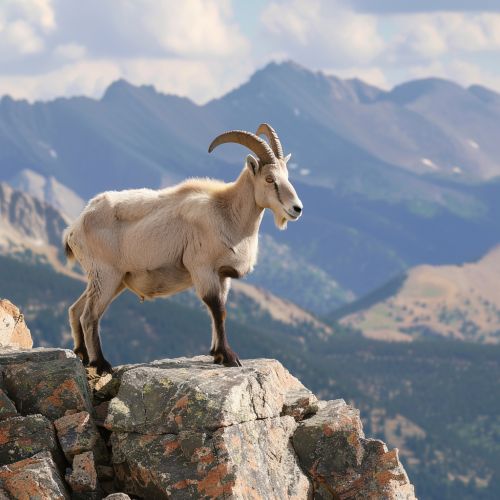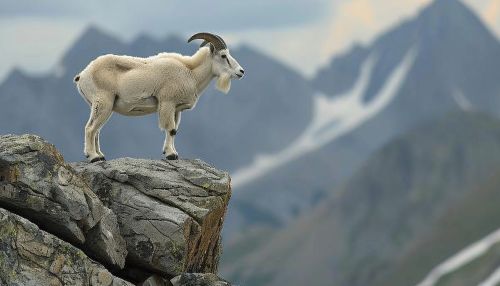Mountain goat
Taxonomy and Evolution
The Mountain goat (Oreamnos americanus), also known as the Rocky Mountain goat, is a large-hoofed mammal found only in North America. A member of the Bovidae family, this species is closely related to antelopes, gazelles, and cattle. It belongs to the subfamily Caprinae, along with 32 other species including true goats, sheep, the chamois, and the musk ox.


Mountain goats are not true goats, but they are close relatives. They are more properly known as goat-antelopes. The mountain goat is the only species in the genus Oreamnos. The name Oreamnos is derived from the Greek term oros (mountain) and the word amnos (lamb).
Description
Mountain goats are large mammals, with adults standing over a meter at the shoulder. Males, or billies, can weigh up to 140 kg (300 lb), while females, or nannies, are somewhat smaller. Both sexes have beards, short tails, and long black horns, 15–28 cm in length, which contain yearly growth rings. They have double coats, with a dense woolly undercoat overlaid with longer, hollow hairs. In spring, mountain goats moult by rubbing against rocks and trees, with the adult billies shedding their extra wool first. Their fur is bright white, providing camouflage in snowy landscapes.
Habitat and Distribution
Mountain goats inhabit the Rocky Mountains and Cascade Range and other mountain regions of the Western Cordillera of North America, from Washington, Idaho and Montana through British Columbia and Alberta, into the southern Yukon and southeastern Alaska. Their altitudinal range is from sea level to over 13,000 feet. They are the largest mammals found in their high-altitude habitats, which can exceed elevations of 13,000 feet. Mountain goats are well suited to climbing steep, rocky terrains and can be seen balancing on cliffs that would be dangerous for most other creatures.
Behavior and Ecology
Mountain goats are diurnal and most active during the early morning and late evening. They are social animals and typically live in groups. Females, or nannies, spend much of the year in herds with their kids, while males either live solitary lives or band together in small groups. Mountain goats are not territorial, and bedding areas are used by many animals in the herd.
During the more mild seasons, mountain goats feed in high alpine meadows, munching on grasses, herbs, sedges, ferns, mosses, lichens, twigs and leaves from the low-growing shrubs and conifers of the high country. As winter descends, food becomes scarcer, and goats move to lower elevations and concentrate in sheltered valleys and basins.
Reproduction
Mountain goats reach sexual maturity at about 30 months. Mating season (or rut) takes place in the fall, during which males fight each other for access to females. In these battles, billies will often use their horns to strike each other. Nannies mate with the winning billy and give birth to one, rarely two, kids in the spring. Kids are precocial, and are able to move around with their mothers immediately after birth.
Conservation
Mountain goats have not been evaluated for the IUCN Red List, and the species does not appear to be facing any major threats. However, their populations are reliant on undisturbed alpine habitats, and potential threats to this species include climate change, habitat loss due to the encroachment of humans into their mountainous habitats, and hunting.
